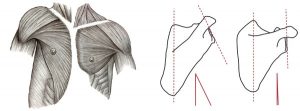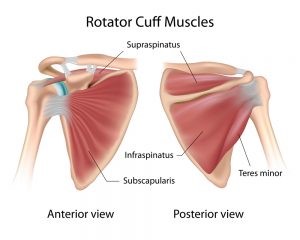Shoulder Joint Evolution and How it was Influenced by Throwing
Posted by Phil Heler on April 10, 2020Our ability to throw accurately and at speed is something that is unique to us and this ability helped influence our shoulder evolution.
I am about to take a break for two weeks for what would have been the Easter holidays. Before I do, my last piece is deservedly on our shoulder joints. Apart from hips and knees this is the next most significantly joint affected by age related changes (to refer to my previous article on hips and knees click this link). There is no doubt that there are some parts of our bodies that could be better designed.
Our dogs, as faithful friends, deserve our respect for their robust cardiovascular system. Canine hearts have many more collateral coronary arteries making them less susceptible to heart attacks with much lower levels of mortality. Their cardiac muscle is better perfused making any occlusions much less significant. Meanwhile other primates such as chimpanzees have only four lumbar spine vertebra and a different pelvic symmetry giving them much stiffer, more stable lower back that would render me redundant!
Our evolutionary design solution for bipedalism is also much less impressive than other species. Birds have a design solution that goes back 250 million years to the age of the dinosaurs, and, in terms of biomechanics, it is vastly superior to our own. For us though bipedalism, despite obvious design flaws, did give us a major advantage as it emancipated our arms, enabling us as foragers to effectively hunt using projectiles and use tools and evolving shoulder evolution. This helped evolution define and model the shoulder joint, such as it is today.
Why was the Ability to Throw Important?
Throwing is something that we are extremely good at. It is a skill unique to us that evolved roughly 2 million years ago. We have the ability to throw with accuracy and at very high speeds. Our friends the chimpanzees with whom we share common ancestry over 7 million years ago can only throw an object at 20 mph. Examples of just how proficient we are at throwing are many. Shoaib Akhtar is regarded as the fastest bowler in the history of cricket. He set an official world record by achieving the fastest delivery of 161.3 km/h (100.2 mph) against England in the 2003 ICC World Cup.
In the Guinness Book of Records the longest throw of an object without any velocity-aiding feature is 427.2 m (1,401.5 ft). This was achieved by David Schummy in Australia with a boomerang on 15 March 2005. The longest ever recorded javelin throw is 104.8 metres. Impressive achievements. Clearly today our prowess at throwing is best demonstrated by our sporting abilities but in a hunter gatherer society this ability would have been prized for very different reasons.
Unlike many carnivores, early man had quite a few innate physical disadvantages. We lacked almost all the scary essential natural weapons such as fangs, venom, claws, antlers, horns, speed, strength and perhaps a thick hide, when compared to other animals. We therefore needed weapons! To kill something in a hunter-gatherer society it was also a really good idea to have a distance between yourself and what you were aiming at for your own safety if it was a large animal. Our ability to throw had the obvious advantage of being a better way to gain access to a calorific rich diet as long as we were accurate.
Diet is of course paramount and the access to food is a key driver in determining the success of a species. Archaeological evidence suggests hunting intensified 2 million years ago and throwing would have been a fantastic asset so much so that it may have even promoted natural selection in humans. Anthropologists now suggest that the ability to throw projectiles would have certainly influenced shoulder evolution..
Throwing Influenced Shoulder Joint Evolution
Whilst we still share many features of upper limb morphology with primates (this reflects our phylogenetic heritage) the small changes that did happen were indeed significant. Throwing is made possible because the ligaments and tendons surrounding the shoulder stretch and store elastic energy, which then converts to power enabling the throwing force (combined with lower limb and trunk movements).
When this energy is released it generates what researchers have found to be the fastest motion the human body can produce. This elastic energy is used to catapult the arm forward and this ability to store energy in the shoulder is made possible by key evolutionary changes. Changes to the anatomy of the torso, shoulder, and arm occurred during human evolution in order to make this elastic energy storage possible.
This image below shows differences in shoulder evolution between our primate cousins’ chimpanzees (left) and humans (right). These differences can be seen in both the muscular anatomy and in the bony anatomy of the scapula (shoulder blade). The next obvious question is, has this unique shoulder evolution come at a cost? Is there a disadvantage?
These Changes meant there were some Sacrifices
The shoulder joint is remarkable in the way it has been driven by evolutionary demands. But unlike any joint in the human body, despite all its wonderful abilities, it is structurally unstable. To allow for this impressive capacity of movement it is unfortunately an incongruous joint (it doesn’t fit together very well!) as least in terms of bony structures. Fundamentally joints like the hip joint have deep sockets but this is not the case with the shoulder joint.
The large ball on the end of the arm bone (or humeral head) moves against what is basically almost a flat surface or a very shallow socket on the shoulder blade. The shoulder complex barely has any bony connection to the rest of the skeleton except for the connection with the clavicle at the acromioclavicular joint (A/C joint). The shoulder is almost encapsulated in a muscular sling.
The Importance of Muscles and Ligaments in Shoulder Joint Stability
Not surprisingly the shoulder joint is therefore very dependent on ligaments and muscles (and their respective tendons) in order to make up for the relative lack of bony connections and congruity of its socket. In fact, it is so dependant that some studies estimate that the restraint force provided by ligaments alone in the shoulder is equivalent to 50-80kg. Balanced muscle control in the shoulder is also very important.
Much of this, allied with yet more shoulder joint compression, is provided by four muscles known as a rotator cuff. In fact, a good metaphor for our shoulder joint socket would be like a golf ball that sits on a shallow small tee! The rotor cuff is important (along with ligaments) as it helps strap the golf ball on the tee, centralising it and keeping it secure. All four rotator cuff muscles work in unison when you lift your arm up and pull the joint together, stabilising your shoulder. The large round golf ball (or humeral head) is necessary as it allows for nearly a complete sphere of motion allowing the hand to be positioned almost anywhere around the body.
Having told you a little about shoulder evolution hopefully this will help you understand it’s failings. Dislocation or ligamentous laxity are unfortunately relatively common. However, the most common issue is damage to the rotator cuff either because of trauma or as part of the ageing process. In fact, it might surprise you to know that rotator cuff tears are the most common non-traumatic upper limb cause of disability in people over 50 years.
In fact, some studies suggest that 40% of people over 50 years old will have small rotator cuff tears although this does not necessarily mean that they are symptomatic. In total in the UK, estimates suggest that between 30-70% of shoulder pain arises from disorders of the rotator cuff. Without doubt it is certainly the most common upper limb condition that we consult for.



